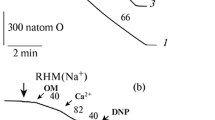Abstract
The inotropic Cd2+ action on frog heart is studied with taking into account its toxic effects upon mitochondria. Cd2+ at concentrations of 1, 10, and 20 mM is established to decrease dose dependently (21.3, 50.3, and 72.0%, respectively) the muscle contraction amplitude; this is explained by its competitive action on the potential-controlled Na2+-channels of the L-type (Cav 1.2). In parallel experiments on isolated rat heart mitochondria (RHM) it was shown that Cd2+ at concentrations of 15 and 25 mM produces swelling of non-energized and energized mitochondria in isotonic (with KNO2 and NH2NO3) and hypoosmotic (with 25 mM CH3COOK) media. Study of oxidative processes in RHM by polarographic method has shown 20 mM Cd2+ to disturb activity of respiratory mitochondrial chain. The rate of endogenous respiration of isolated mitochondria in the medium with Cd2+ in the presence of malate and succinate was approximately 5 times lower than in control. In experimental preparations, addition into the medium of DNP—uncoupler of oxidation and phosphorylation did not cause an increase of the oxygen consumption rate. Thus, the obtained data indicate that a decrease in the cardiac muscle contractility caused by Cd2+ is due not only to its direct blocking action on Ca2+-channels, but also is mediated by toxic effect on rat heart mitochondria, which was manifested as an increase in ion permeability of the inner mitochondrial membrane (IMM), acceleration of the energy-dependent K+ transport into the matrix of mitochondria, and inhibition of their respiratory chain.
Similar content being viewed by others
References
Makhon’ko, M.N. and Lavrentiev, M.V., About Cadmium Effect on the Cardiovascular System under Conditions of Technology, Sovremennye naukoemkie tekhnologii. Nauchnye issledovaniya vysshei shkoly po prioritetnym napravleniyam nauki i tekhniki (Modern Science-Based Technologies. Scientific Studies of Higher School on the Priority Directions of Science and Technology), Abstr. Intern. Sci. Conf., Savona-Hamburg, May 6–16, 2008, no. 5, p. 67.
Wasserstrom, J.A. and Vites, A.M., Activation of Contraction in Cat Ventricular Myocytes: Effects of Low Cd2+ Concentration and Temperature, Am. J. Physiol., 1999, vol. 277, pp. H488–H498.
Korotkov, S.M., Nesterov, V.P., and Ryabchikov, N.N., About Effect of SH-Groups on the Mitochondrial Respiration and Swelling in Rat Heart, Dokl. RAN, 2008, vol. 421, pp. 123–127.
Berwe, D., Gottschalk, G., and Luttgau, H.C., Effects of the Calcium Antagonist Gallopamil (D600) upon Excitation-Contraction Coupling in Toe Muscle Fibers of the Frog, J. Physiol., 1987, vol. 385, pp. 693–707.
Shemarova, I.V., Korotkov, S.M., Demina, I.N., and Nesterov, V.P., Effect of Oxydative Processes in Mitochondria on the Heart Muscle Contraction. Ni2+ Effects, Zh. Evol.Fiziol. Biokhim., 2010, vol. 46, pp.138–142.
Bradford, M.M., A Rapid and Sensitive Method for the Quantitation of Microgram Quantities of Protein Utilizing the Principle of Protein-Dye Binding, Anal. Biochem., 1976, vol.72, pp. 248–254.
Shemarova, I.V., Kuznetsov, S.V., Demina, I.N., and Nesterov, V.P., Role of Acetylcholine in Ca2+-Depended Regulation of Functional Activity of Myocardium of Frog Rana temporaria, Zh. Evol. Fiziol. Biokhim., 2008, vol. 44, pp.591–602.
Wang, X., Evans, C., and Mendelowitz, D., Voltage Gated P/Q and N-Type Calcium Channels Mediate the Nicotinic Facilitation of GABAergic and Glycinergic Inputs to Cardiac Vagal Neurons, Neuropharmacol., 2004, vol. 46, pp. 372–378.
Shen, J.B., Jiang, B., and Pappano, A.J., Comparison of L-Type Calcium Channel Blockade by Nifedipine and/or Cadmium in Guinea Pig Ventricular Myocytes, J. Pharmacol. Exp. Ther., 2000, vol. 294,pp. 562–570.
Kocksk’ämper, J., Zima, A.V., Roderick, H.L., Pieske, B., Blatter, L.A., and Bootman, M.D., Emerging Roles of Inositol 1,4,5-Trisphosphate Signaling in Cardiac Myocytes, J. Mol. Cell. Cardiol., 2008, vol. 45, pp. 128–147.
Fares, N., Jebara, V., Corbi, P., Bois, P., and Potreau, D., Evidence for Expression of a Nifedipine Resistant L-Type Calcium Current in Human Atrial Cardiomyocytes, J. Med. Liban., 2008, vol.56, pp. 168–173.
Shemarova, I.V., Kuznetsov, S.V., Demina, I.N., and Nesterov, V.P., T-Channels and Na+, Ca2+-Channels as Components of the Ca2+-System of Regulation of Activity of Heart Myocardium of Frog Rana temporaria, Zh. Evol. Fiziol. Biokhim., 2000, vol. 45, pp.319–328.
Milos, M., Comte, M., Schaer, J.J., and Cox, J.A., Evidence for Four Capital and Six Auxiliary Cation-Binding Sites on Calmodulin:Divalent Cation Interactions Monitored by Direct Binding and Microcalorimetry, J. Inorg. Biochem., 1989, vol.36, pp. 11–25.
Xu, B., Xu, Z.F., Deng, Y., and Yang, J.H., Protective Effects of Chlorpromazine and Verapamil against Cadmium-Induced Kidney Damage in vivo, Exp. Toxicol. Pathol., 2010, vol. 62, pp. 27–34.
Teleman, O., Drakenberg, T., Forsén, S., and Thulin, E., Calcium and Cadmium Binding to Troponin C. Evidence for Cooperativity, Eur. J. Biochem., 1983, vol. 134, pp. 453–457.
Korotkov, S.M., Skulskii, I.A., and Glazunov, V.V., Cd2+ Effects on Respiration and Swelling of Rat Liver Mitochondria Were Modified by Monovalent Cations, J. Inorg. Biochem., 1998, vol.70, pp. 17–23.
Lee, W.K., Spielmann, M., Bork, U., and Thévenod, F., Cd2+-Induced Swelling-Contraction Dynamics in Isolated Kidney Cortex Mitochondria: Role of Ca2+ Uniporter, K+ cycling, and Protonmotive Force, Am. J. Physiol. Cell Physiol., 2005, vol. 289, pp. C656–C664.
Mitchell, P. and Moyle, J., Translocation of Some Anions, Cations and Acids in Rat Liver Mitochondria, Eur. J. Biochem., 1969, vol. 9, pp. 149–155.
Makhmudova, E.M., Tashmukhamedov, B.A., Gagelgans, A.K., and Shkinev, A.V., Action of Hexaminecobalt Chloride on Transport of Bialent Cations in Liver Mitochondria, Biokhimiya, 1975, vol. 40, no. 2, pp. 257–262.
Yamaguchi, M., Mochizuki, A., and Okada, S., Role of Zinc as an Activator of Mitochondrial Function in Rat Liver, Biochem. Pharmacol., 1982, vol. 31, pp. 1289–1293.
Author information
Authors and Affiliations
Additional information
Original Russian Text © I. V. Shemarova, S. M. Korotkov, V. P. Nesterov, 2011, published in Zhurnal Evolyutsionnoi Biokhimii i Fiziologii, 2011, Vol. 47, No. 4, pp. 306–310.
Rights and permissions
About this article
Cite this article
Shemarova, I.V., Korotkov, S.M. & Nesterov, V.P. Effect of oxidative processes in mitochondria on contractility of heart muscle of the frog Rana temporaria. Actions of Cd2+ . J Evol Biochem Phys 47, 360–365 (2011). https://doi.org/10.1134/S0022093011040074
Received:
Published:
Issue Date:
DOI: https://doi.org/10.1134/S0022093011040074



